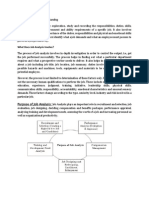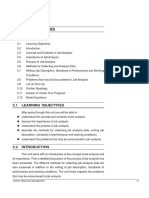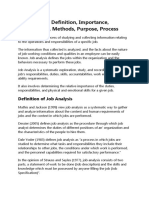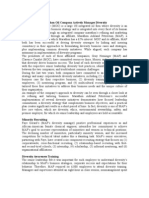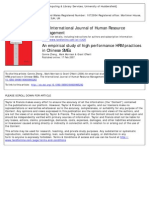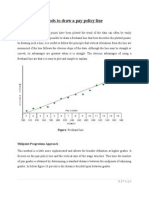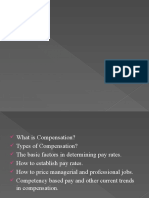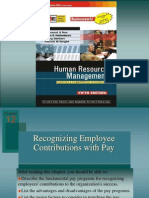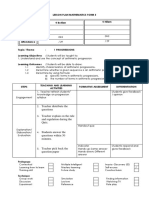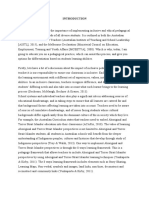Job Design JOB ANALYSIS
Job Design JOB ANALYSIS
Uploaded by
Ashish Kumar GwalCopyright:
Available Formats
Job Design JOB ANALYSIS
Job Design JOB ANALYSIS
Uploaded by
Ashish Kumar GwalOriginal Description:
Copyright
Available Formats
Share this document
Did you find this document useful?
Is this content inappropriate?
Copyright:
Available Formats
Job Design JOB ANALYSIS
Job Design JOB ANALYSIS
Uploaded by
Ashish Kumar GwalCopyright:
Available Formats
Hr planning, recruitment and selection
1.
2.
1. JOB ANALYSIS, DESIGN AND EVALUATION
2. JOB ANALYSISthe process of systematicallydetermining the essentialcomponents of a job the duties,skills and
qualifications required ofthe employee. Such data may begathered through interviews with theemployees and their
respectivesupervisors, job observations, andthe use of a questionnaire
3. 3. JOB DESCRIPTIONrefers to the following: job title,division and department, nature ofthe job, duties and
responsibilities,methods and tools used, hours ofwork, the person to whom theemployee is accountable, funds
orproperties responsible for,compensation, benefits andprivileges, hazards and risks, andpotentials for promotion.
4. 4. JOB SPECIFICATIONSspecification list the neededqualifications of the employee who issupposed to be appointed for
the jobdescribed. It specifies theeducational qualifications, workexperience, psychological traitsparticularly the mental
andpersonality characteristics, healthstatus, special qualification like age,sex, status and special skills.
5. 5. RANK CLASSIFICATION SYTEM vs. POSITION CLASSIFICATION
6. 6. RANK CLASSIFICATION SYTEM POSITION CLASSIFICATIONit is the person or incumbent of the Each rank
requires certainposition or job who is classified. credentials such as masters orThe persons official rank in the doctorates
degree, experience andorganization will depend on seniority.educational qualifications, training, The faculty maintains
his/her rankexperiences, achievements and regardless of the discipline he/sheseniority. specializes in and regardless of
theThe employee is paid in accordance courses he/she teaches, whetherwith the rank and not according to graduate or
undergraduate courses.the kind of work that is actually it is the position that is classifiedperformed. and not the person or
theThis means that the rank is incumbent. The classification isattached to the person and that is based on the duties
andcarried to wherever the person is responsibilities required by theassigned including the salary grade position or the
functions that areattached to the rank required to be performed by the incumbents.
7. 7. Uses of Job Analysis provides critical inputs to management decision- making particularly in relation to the recruitment
and selection of personnel analysis reveals the areas in which the new employee has to be trained to successfully perform
the tasks in the assigned job. provide critical information about work relationships in a particular unit or department as well
as among departments in the whole organization. assist management in coming up with standards for work performance
also serve as a tool for evaluating jobs in the organization management can be guided to determine the movement of
employees by promotion, demotion, transfer, layoff, or resignation.
8. 8. In this technique, you have to interview the employees orworkers to ascertain which of the activities they performcould
be considered critical in the effective performance intheir jobs. Rather than identify you have to interview the employees
or workers toascertain which of the activities they perform could beconsidered critical in the effective performance in their
jobs.Rather than identifying all the relevant employee activitiesas is done in the functional job language technique, you
willidentify only those crucial to effective performanceThe Critical Incident TechniqueMethods of Job AnalysisThe
Functional Job Language Technique.ing all the relevant employeeactivities as is done in the functional job
languagetechnique, you will identify only those crucial to effectiveperformance.
9. 9. To use this technique, you have to prepare a standardquestionnaire which will be used to build a profile of any job
andrank it relative to others based on certain broad categories aswork relationship, work environment or job situation.
more of a quantitative procedure used to question a panel ofexpert about the important activities of the employee. You
willask each expert about an element to determine its importancein the job to be done. Job element usually human
qualities ortraits and not behaviors. The expert panel is selected bymanagement. This panel usually composed of
employees andsupervisors performing the same job or within the same jobcategory.The Positive Analysis Questionnaire
TechniqueThe Job Element Technique
10. 10. Job Designthe process of determining thecontent, functions, and relationships of jobs in away which meets the goals
and interests of theorganization and the employee. The content of ajob includes the various tasks to be carriedout, the
autonomy of the job holder, the routinesof the tasks performed, the difficulty of the taskscarried out, and the identity of the
job holder.The functions of a job include the work methodsemployed and the coordination of thework, responsibility,
information flow, andauthority of the job. The relationships of the jobrefer to the shared work between and
amongemployees in the agency
11. 11. Approaches to Job DesignJob rotationA technique used to enhance employeemotivation is job rotation. This
involvesperiodically assigning employees to alternatingjobs or tasksJob enlargementThe main purpose of this technique is
also toreduce boredom through job enlargement whichincreases the scope of the work. In other words,the tasks being
performed are enlarged suchthat the methods of operation are changed andin turn, the pace of the work is changed
12. 12. Employee-centered work designEmployees are encouraged to be involved inredesigning their work to make their work
moresatisfying. The work changes to be introduced shouldbe designed to accomplish the over-all objectives/goalsof the
13.
14.
15.
16.
17.
18.
19.
20.
department or unit.Job enrichmentjobs are redesigned in scope and in depth. Scope refersto the dimension of the job
concerned with the lengthof time an employee takes to complete the jobReengineeringinvolves the processes of
restructuring, downsizing, orautomating the organization to make it more productiveand efficient. Included in the process is
the applicationof new technology to allow employees to work moreefficiently and effectively.
13. Job Evaluation is a systematic process of comparingjobs to determine their relative worth to the organization. This kind
of job analysis is the basis of a job hierarchy and pay range. The result of this is a pay system with the pay rate for eachjob
commensurate with its status within the job hierarchy
14. HR PLANNING,RECRUITMENT AND SELECTION
15. HR Planning Begins with a review of the human resources needs in the light of organizational goals and plans for
ensuring the employment of competent, qualified and stable work force Closely related to staffing process where an
analysis of the skills level among employees is done in addition to an analysis of the external labor market
16. HR Planning Forecast the need for the additional personnel over some future period of time(Estimates the future
human resources needs of the organization based on personnel turnover, retirement, promotion and expansion) Survey
the skills levels among the employees and in the job market (Estimates of future labor supply based on economic
projections, population movement, trends in education, and rate of promotion w/in the organization ) Decide on ways to
meet the need
17. The Human Resource Planning Process EXTERNAL ENVIRONMENT INTERNAL ENVIRONMENT Strategic Planning
Human Resource Planning Forecasting Comparison of ForecastingHuman Resource Requirements Human Resource
Requirements and Availability Availability Demand Surplus Shortage of = of Workers Supply Workers Restricted Hiring,
Recruitment No Reduced Hours; Action Early Retirement Selection Layoff
18. RECRUITMENT AND SELECTION PROCESSRECRUITMENT- refers to the process of attractingapplications from
peopleSELECTION- process of measuring andassessing the characteristics ofapplicants and choosing thosepersons who
are most likely tosucceed on the job
19. FACTORS AFFECTING THE RECRUITMENT PROCESSORGANIZATIONAL FACTORS- Perception about the
organization- Growth opportunities- Reward system- Leadership and management styleEXTERNAL FACTORS- Supply
and Demand of Labor- Social attributes on particular type of employmentRECRUITMENT W/IN & OUTSIDE
THEORGANIZATION
20. SELECTION PROCESSSelecting the best candidates among theapplicants on the basis of certain factors whichrange
from the concrete and measurable to theabstract and personal like leadership andpotential.SELECTION TEST- Measures
of Proficiency, achievement or knowledge- Measures of aptitude or potential- Measures of mental ability- Measures of
interest- Measures of personality- Measures of substance abuse
You might also like
- Chapter 9Document14 pagesChapter 9ranne18No ratings yet
- Gym - Ocean RescueDocument2 pagesGym - Ocean Rescueapi-267119096No ratings yet
- Handbook of Clinical Behavior Therapy & Adults by Michel HersenDocument728 pagesHandbook of Clinical Behavior Therapy & Adults by Michel HersenGeorge100% (3)
- Jalowiec Coping Scale OverviewDocument3 pagesJalowiec Coping Scale OverviewShandy100% (4)
- Detailed Lesson Plan (DLP) : Nature and Elements of CommunicationDocument2 pagesDetailed Lesson Plan (DLP) : Nature and Elements of CommunicationJesslyn Mar Genon100% (2)
- Job AnalysisDocument9 pagesJob AnalysisSalam ZeeshanNo ratings yet
- Job AnalysisDocument6 pagesJob AnalysisAreeba ArifNo ratings yet
- Job AnalysisDocument42 pagesJob AnalysisShikha DeshpandeNo ratings yet
- Job Analysis and Evaluation A NovidDocument13 pagesJob Analysis and Evaluation A NovidDimas FatmalaNo ratings yet
- Job Analysis Is A Systematic ExplorationDocument14 pagesJob Analysis Is A Systematic ExplorationSwati JainNo ratings yet
- Job Analysis MethodsDocument4 pagesJob Analysis MethodsSaleh RehmanNo ratings yet
- Unit 3 Job AnalysisDocument14 pagesUnit 3 Job AnalysisHari Prasad AnupojuNo ratings yet
- CBHRM AjayDocument12 pagesCBHRM AjayAjay PhalkeNo ratings yet
- Design of Work Systems: Mcgraw-Hill/IrwinDocument32 pagesDesign of Work Systems: Mcgraw-Hill/IrwinSagar Murty100% (1)
- Job Analysis and HRPDocument32 pagesJob Analysis and HRPtony_njNo ratings yet
- Job Analysis - Models and Other InfoDocument23 pagesJob Analysis - Models and Other InfoharidhraNo ratings yet
- What Is Job Analysis? Why Is Job Analysis Important?Document18 pagesWhat Is Job Analysis? Why Is Job Analysis Important?Aljunex LibreaNo ratings yet
- 5IVP Assessment Activities Version B.3 June 2019-JamalDocument22 pages5IVP Assessment Activities Version B.3 June 2019-JamalShahroz100% (3)
- Assignment - 4Document23 pagesAssignment - 4lekha magantiNo ratings yet
- Research Design and Execution of The StudyDocument74 pagesResearch Design and Execution of The StudyhonoureengomesNo ratings yet
- HR Analytics An IntroductionDocument17 pagesHR Analytics An IntroductionMuskan ManchandaNo ratings yet
- Job Evaluation AssignmentDocument4 pagesJob Evaluation AssignmentRichard DeniranNo ratings yet
- Marathon Oil Company Actively Manages DiversityDocument6 pagesMarathon Oil Company Actively Manages DiversityabdulhadiqureshiNo ratings yet
- Benchmarking Process For Product Development: A Project Reports ONDocument38 pagesBenchmarking Process For Product Development: A Project Reports ONVISHAL PAHURKARNo ratings yet
- Pay Equity Internal and External Conside PDFDocument9 pagesPay Equity Internal and External Conside PDFOnline AccessNo ratings yet
- Analysis of Work, Designing Jobs and Job EvaluationDocument16 pagesAnalysis of Work, Designing Jobs and Job Evaluation9811147948No ratings yet
- The International Journal of Human Resource ManagementDocument33 pagesThe International Journal of Human Resource ManagementAhmar ChNo ratings yet
- Retention of Human CapitalDocument70 pagesRetention of Human CapitalHugo Zavala RodríguezNo ratings yet
- Compensation ManagementDocument45 pagesCompensation ManagementAjjarapu JaikaliprasadNo ratings yet
- Methods To Draw A Pay Policy LineDocument3 pagesMethods To Draw A Pay Policy LineTausiff HossainNo ratings yet
- Talent ManagementDocument15 pagesTalent ManagementAshwitha Karkera0% (1)
- Compensation Is The Results or Rewards That The EmployeesDocument8 pagesCompensation Is The Results or Rewards That The EmployeeskomalNo ratings yet
- Job Analysis and Talent ManagementDocument36 pagesJob Analysis and Talent ManagementMT planet100% (1)
- Recruitment HondaDocument16 pagesRecruitment HondamayankNo ratings yet
- Introduction and Evolution: Critical Factors For Erp ImplementationDocument1 pageIntroduction and Evolution: Critical Factors For Erp ImplementationYasir MuhibullahNo ratings yet
- JVH PHANI Performance Review System Mba HR ProjecDocument49 pagesJVH PHANI Performance Review System Mba HR ProjecKRISHNA SASTRYNo ratings yet
- ADIBDocument11 pagesADIBLoloPkNo ratings yet
- HR Audit: Kirti Shivakumar Mats School of BusinessDocument13 pagesHR Audit: Kirti Shivakumar Mats School of Businessreemasingh0088No ratings yet
- Pay StructureDocument7 pagesPay StructureHabeel ZahidNo ratings yet
- Compensation Establishing Strategic Pay PlansDocument46 pagesCompensation Establishing Strategic Pay PlansSunil SinghNo ratings yet
- Presentation On Internal AlignmentDocument24 pagesPresentation On Internal AlignmentAman KaurNo ratings yet
- Module 1 AssignmentDocument6 pagesModule 1 AssignmentAbhishek KumarNo ratings yet
- HRM Final AssignmentDocument10 pagesHRM Final AssignmentAhmed SharifNo ratings yet
- CM Institute of Management: MBA II Year II Sem Question Bank Subject TKMDocument7 pagesCM Institute of Management: MBA II Year II Sem Question Bank Subject TKMShiva Kumar MallakNo ratings yet
- Recruitment and SelectionDocument13 pagesRecruitment and SelectiondikshaNo ratings yet
- Explain How You Would Conduct A Job Analysis in A Company That Has Never Had Job DescriptionsDocument3 pagesExplain How You Would Conduct A Job Analysis in A Company That Has Never Had Job DescriptionsN. AzadNo ratings yet
- Discussion Activity-Reflection (2/5) Surya Prakash Bhandari 8695493 Human Resources Management HRM8130 Heather Fitzgerald 14 June, 2020Document4 pagesDiscussion Activity-Reflection (2/5) Surya Prakash Bhandari 8695493 Human Resources Management HRM8130 Heather Fitzgerald 14 June, 2020surya prakash bhandariNo ratings yet
- Recognizing Employee Contributions With PayDocument19 pagesRecognizing Employee Contributions With PayahmedjameelNo ratings yet
- Job Enrichment NotesDocument9 pagesJob Enrichment Notesnilakshi_nillu100% (1)
- Demand and Supply ForecastingDocument19 pagesDemand and Supply ForecastingRavi VermaNo ratings yet
- New Model of Job Design Motivating EmploDocument18 pagesNew Model of Job Design Motivating EmploAlbertus DaruNo ratings yet
- Personnel Management: Personnel:-It Is Defined As People Employed in An Organization or EngagedDocument30 pagesPersonnel Management: Personnel:-It Is Defined As People Employed in An Organization or EngagedharpreetNo ratings yet
- How To Design An Organization StructureDocument3 pagesHow To Design An Organization StructureShereen HossamNo ratings yet
- Unit 2: Acquisition of Human ResourceDocument50 pagesUnit 2: Acquisition of Human ResourcePriyank Gangwal100% (1)
- AssignmentDocument7 pagesAssignmentMD Shakin IslamNo ratings yet
- Typical Reasons For Employee Training and DevelopmentDocument6 pagesTypical Reasons For Employee Training and DevelopmentAnuradha SuryanNo ratings yet
- Job EvaluationDocument15 pagesJob EvaluationAnkur DubeyNo ratings yet
- ETHICSsDocument31 pagesETHICSsShanky RanaNo ratings yet
- Recruitment and SelectionDocument9 pagesRecruitment and SelectionarchangelkhelNo ratings yet
- JOb Evaluation and Job Grade3Document3 pagesJOb Evaluation and Job Grade3Tamer Maher100% (1)
- Ms. Truitt's Classroom Management PlanDocument7 pagesMs. Truitt's Classroom Management Planapi-263392674No ratings yet
- RPH QuizDocument6 pagesRPH QuizTeresah KumilauNo ratings yet
- Chapter 1-AnswersDocument11 pagesChapter 1-Answersdeepika singhNo ratings yet
- Positive Psychology: Chapter #11 Internet ResourcesDocument7 pagesPositive Psychology: Chapter #11 Internet ResourcesSaifullah WaseemNo ratings yet
- Examples of Feedback QuestionnairesDocument5 pagesExamples of Feedback QuestionnairesnavdinNo ratings yet
- Schemes MentalsDocument50 pagesSchemes MentalsJenny VarelaNo ratings yet
- Campbell Chloe 1088079 Edu412 Task1Document8 pagesCampbell Chloe 1088079 Edu412 Task1api-453388446No ratings yet
- Open ClassesDocument152 pagesOpen ClassesRodrigo RomeroNo ratings yet
- PDR 3 - Learning Disabilities Annotated BibliographyDocument4 pagesPDR 3 - Learning Disabilities Annotated Bibliographyapi-313083387No ratings yet
- Chak de IndiaDocument33 pagesChak de IndiaNirav ShahNo ratings yet
- Formal Lesson 3 - Writing A Book ReviewDocument6 pagesFormal Lesson 3 - Writing A Book Reviewapi-271874263No ratings yet
- Leadership Coach Performance Consultant in CO Resume Kimberlee AckerDocument2 pagesLeadership Coach Performance Consultant in CO Resume Kimberlee AckerKimberleeAckerNo ratings yet
- TICC Distressed Student HandbookDocument58 pagesTICC Distressed Student HandbookSumanNo ratings yet
- Activity 4 AssessmentDocument2 pagesActivity 4 AssessmentVanessa B. Padua0% (1)
- 4 PDFDocument6 pages4 PDFDr.V.Bastin JeromeNo ratings yet
- DLL in Hope 3Document3 pagesDLL in Hope 3Donajei Rica100% (3)
- Book Review Getting The Love You Want A Guide For CouplesDocument3 pagesBook Review Getting The Love You Want A Guide For CouplesNarcis NagyNo ratings yet
- When Children Fail in School: What Teachers and Parents Need To Know About Learned HelplessnessDocument6 pagesWhen Children Fail in School: What Teachers and Parents Need To Know About Learned HelplessnessThe Psycho-Educational Teacher100% (1)
- Esp Practitioner v2Document2 pagesEsp Practitioner v2dixon_vanderNo ratings yet
- The Most Common Cognitive Distortions: 1. FilteringDocument8 pagesThe Most Common Cognitive Distortions: 1. FilteringGita ManiNo ratings yet
- Learning: Dr. Rowena M. Cuevillas ProfessorDocument19 pagesLearning: Dr. Rowena M. Cuevillas ProfessorJericko ArtetaNo ratings yet
- Myers Pel3e Clicker Questions Ch01Document4 pagesMyers Pel3e Clicker Questions Ch01brownsugrrNo ratings yet
- References of Scopus International JournalDocument3 pagesReferences of Scopus International Journalageng triyonoNo ratings yet
- The Effects of Written Goals On PerformanceDocument44 pagesThe Effects of Written Goals On PerformanceMaj ImanNo ratings yet
- Kursus Pedagogi Pemulihan Bahasa Inggeris Kepada Guru Bahasa Inggeris TAHUN 1, 2015 DaerahDocument5 pagesKursus Pedagogi Pemulihan Bahasa Inggeris Kepada Guru Bahasa Inggeris TAHUN 1, 2015 Daerahellya2228No ratings yet
- Lesson Plan Healthy HabitsDocument4 pagesLesson Plan Healthy HabitsEnrique Ruiz CanoNo ratings yet






